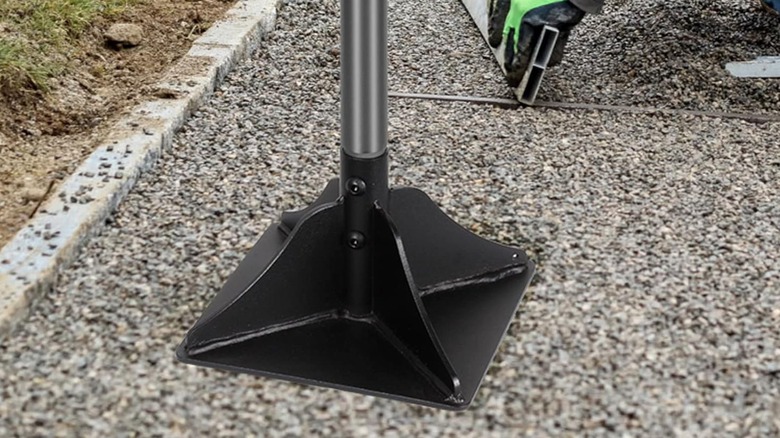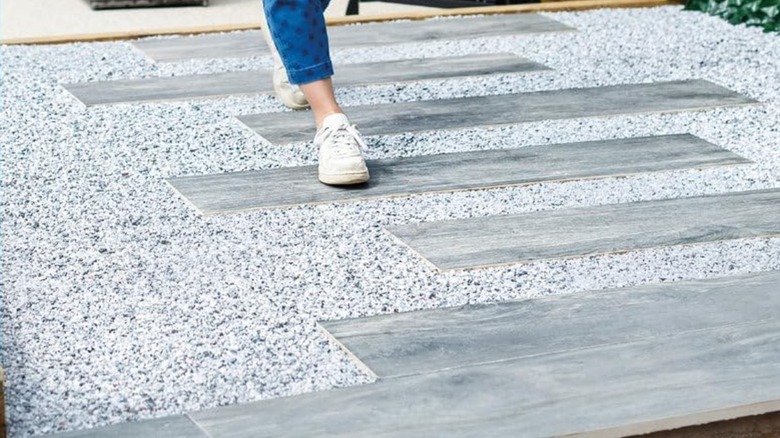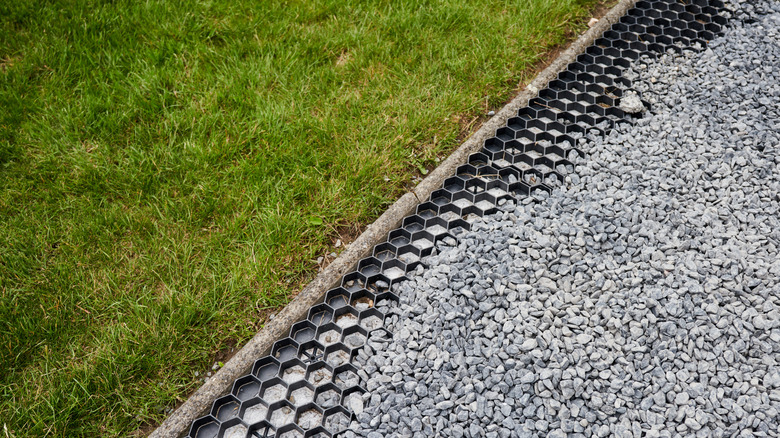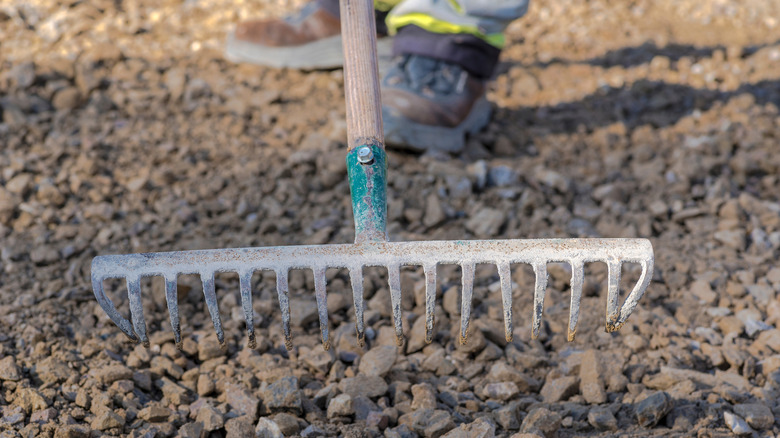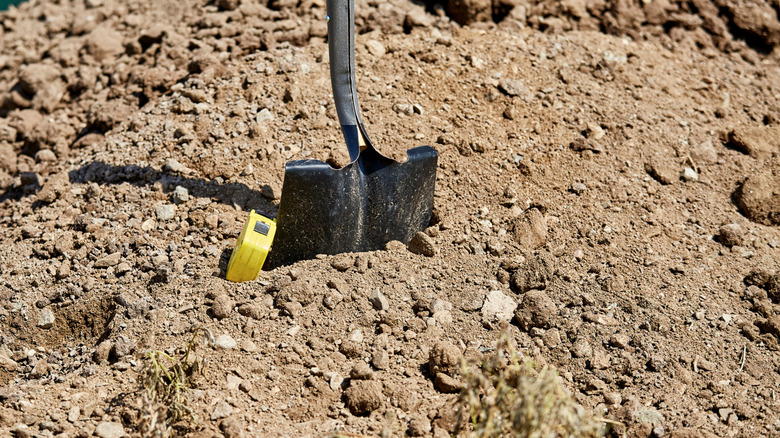The 6 Best Ways To Keep Your Gravel Driveway Secure And Locked In Place
We may receive a commission on purchases made from links.
There are a lot of benefits associated with gravel driveways. Beyond being more affordable than asphalt or concrete, gravel is also easier to install and maintain yourself. Gravel driveways also provide better drainage to keep water from collecting in your yard and you can add more stones as needed. However, while gravel driveways are cost-effective, you should also understand some of the drawbacks that come with them. One of these is feeling like you are constantly needing to add more gravel because what you have isn't staying in place.
Fortunately, there are a few things you can do to ensure that the gravel isn't shifting around, getting washed away, or piling up in certain areas of the driveway. And, even better, many of these tips can be implemented to fix an existing driveway. This way, you won't feel like you need to clear the gravel away and start from scratch (though there are some ideas for those who are laying a new driveway, too). So, here are some solutions to help keep your gravel in place.
Compact the gravel to ensure it doesn't move around
If too much gravel is shifting around on your driveway, it could be because it is too loose. Each piece of gravel is small and light, so a heavy wind or strong rain can easily cause them to move to a new spot on the driveway or even wash away completely. Compacting the material is a relatively simple fix that you should start with if you haven't tried it. This process consists of using something heavy to push all the pieces down to form a denser and more solid surface.
Before you attempt to compact your driveway, start by using a rake to ensure it's even. Once everything is where it belongs, you need to use something very heavy to push all the little pieces of rocks down. You can try a hand tamper, like the Walensee Steep Tamper. Home Depot and other hardware stores also rent plate compactors. If you have a large driveway or are looking for the most efficient solution, it may be worth the cost to give one of these a try.
Apply mulch glue to the driveway to prevent it from shifting
When you're looking for an effective solution to lock a gravel driveway into place, you should consider mulch glue. If you're not familiar with mulch glue, it is a special adhesive designed for landscaping projects. It can keep smaller materials, like mulch or gravel, in place to prevent them from sliding around. Funepoxy's Mulch Glue for Landscaping and other similar products are also permeable. This means that water can still pass through, helping to prevent puddles from forming.
Applying mulch glue is a relatively easy DIY project that you should be able to complete on your own. All you need to do is mix the adhesive with water following the ratio recommended by the manufacturer. Then, add it to a garden sprayer, like the Chapin 20000 Lawn and Garden Pump, and spray it over the entire driveway. You should notice an immediate improvement in how well the gravel pieces stay in place after trying this trick.
Edge the driveway to contain the gravel
A driveway without edging is like a school playground without a fence. Without something to contain the gravel (or the kids) you can't expect them to stay securely in place. If your driveway doesn't have edging, then now is the perfect time to add some to help prevent gravel from migrating into your yard. Edging can also help minimize erosion and the number of stones that wash away during a rainstorm. Beyond helping contain gravel, edging offers additional benefits as well. It will give you a cleaner, more attractive border that's easier to mow along.
There are a few different materials you can consider when edging your gravel driveway. Each comes with its own set of pros and cons related to cost, maintenance, and aesthetic appeal. Depending on the look you want, potential edging materials include bricks, river rocks, cobblestones, wood, and metal, plastic, or rubber strips.
When laying a new gravel driveway, be sure to work in layers
If you are laying a new gravel driveway, you can take measures to minimize how much it will shift in the future. It is important to follow important layering techniques to create a solid and sturdy surface. A gravel driveway should consist of three layers using various-sized stones. When building out a gravel driveway, many people make mistakes like choosing the wrong-sized pieces for some or all of these layers (or failing to even install it in layers). However, just tossing down a layer of stone will set you up for a very loose driveway. This will experience a lot of shifting as water, wind, and cars cause them to move around.
Instead, the first layer of gravel on the driveway should utilize larger stones. Each of these stones should have a diameter of at least 2 inches. To provide a stable base for the driveway, this layer should be about 4 inches deep. After this first layer, you're still not ready for the small pebbles that most of us associate with gravel driveways. Instead, you'll need a middle layer of medium-sized stones about the size of a golf ball. This provides a good transition between the larger base stones and the smaller pebbles that will be laid above.
After laying the bottom and middle layers of larger stones, you're ready for the finer top layer using something like pea gravel or crushed stones. Before laying these, though, you should mix them with rock dust to help further stabilize the driveway. Spread a small layer at a time, pausing to compact the stones down using a tamper before applying new gravel pieces.
Try plastic permeable pavers to stop gravel from moving
If you're worried about the gravel in your driveway eroding or blowing away, another solution to try is using a permeable foundation, such as the TrueGrid Pro Lite Pavers. These plastic grids are designed to be easy to install and maintain. They connect (without the need for any tools) to form a base that holds gravel and keeps it in place while still allowing water to drain. Because of this, water won't pool on the surface of the driveway, threatening your yard or washing any gravel away with it.
If you have a sloped driveway, permeable pavers can be especially helpful. Obviously, the risk of gravel washing down a steep slope is much higher than it is on a flat surface. However, when you use these pavers, the gravel will remain locked in place in the slots within the pavers.
Dig a trench parallel to the driveway to collect rainwater
When too much water collects on the surface of a driveway, it results in increased erosion. One way to reduce how much water is collecting is to dig a drainage trench next to it. The water will be diverted away from the driveway (and the rest of your yard), protecting these surfaces from erosion and other types of damage.
A channel drain is one type of trench that is often recommended for use along driveways. They have a relatively long and narrow design and are relatively flat so they won't have too much of an impact on your landscaping. Because the length of a channel drench is customizable, it is also a good fit for use next to a driveway. For example, Source 1's Trench & Driveway Channel Drain comes in 10-foot segments, so you can connect as many as you need. You can install a drainage trench yourself, if you are comfortable doing so and have the necessary tools. However, depending on your skill level and the complexities of your specific situation, you may want to hire a professional. Many landscaping companies will provide this service, along with plumbers or water management specialists.

